In mid-October, the spread of the coronavirus began to increase again in Sweden after being fairly constant during the late summer and autumn. Parallel to the rising infection rate, Swedes consumption of news plus confidence in the media coverage also increased. These are the latest findings of a study being conducted by the Swedish non-profit organisation VA (Public & Science).
In collaboration with researchers from the Karolinska Institute and Södertörn University, VA (Public & Science) is conducting a study of how people are receiving and interpreting information about the coronavirus and the ongoing pandemic. Here, we present the findings from the tenth wave of the survey, which was undertaken between 17 and 22 October 2020.
The infection rate in Sweden is currently rising rapidly. This probably means that the pattern may have changed further since October. Our eleventh survey began on 17 November, the day after the announcement of new restrictions in Sweden, which included a drastic reduction in the number of participants that can attend public gatherings. The results from the November wave of the survey will be published in early December.
More Swedes are following and trust the news reporting
Corona news reporting was followed by more Swedes in October compared to in mid-September. The most common source of news was Swedish Television (SVT), which 60 percent of Swedes said they had consumed during the preceding two days. The second most common news medium was TV4 (35 percent). Consumption of both of these, together with local morning newspapers, increased the most compared to a month earlier.
One in ten (nine percent) of Swedes said that they had not accessed any information about the coronavirus in the preceding two days. This is a decrease of four percentage points since September. Supporters of the Moderates and the Sweden Democrats were less likely to consume information about the coronavirus compared to supporters of other political parties. As in previous waves of the survey, we can also see an age difference whereby older people accessed information about corona to a greater extent than younger people. Among those aged 65 years or older, the proportion that had not consumed any news about the coronavirus was only two percent.
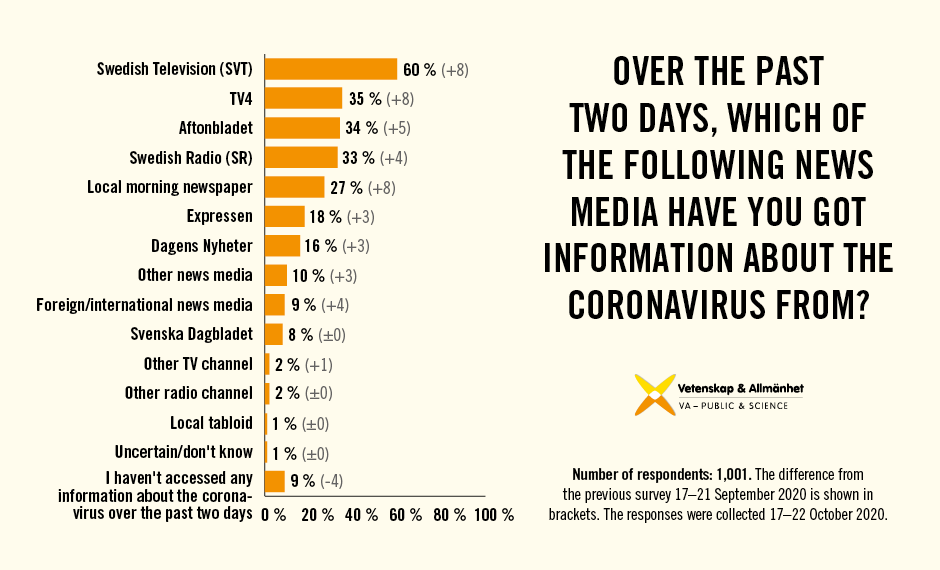
In parallel to this increase in news consumption, public confidence in the media’s coverage of the coronavirus has also clearly risen between September and October. The increase can be seen for all the media included in the survey and was greatest for TV4 and Dagens Nyheter. Confidence remained highest for SVT and Swedish Radio.
Compared with other media included in the survey, a significantly larger proportion of Swedes had fairly or very low confidence in the evening newspapers Aftonbladet and Expressen. Within this group it was 35 percent for Aftonbladet and 33 percent for Expressen, compared with 7–13 percent for other media.
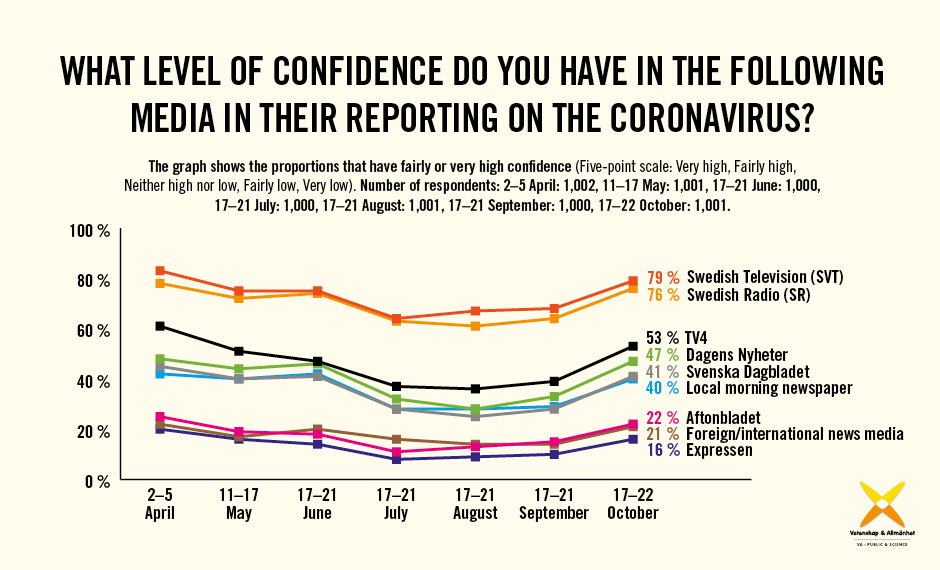
Tone of reporting more alarmist
Since the first survey in March, the tone of reporting on the coronavirus in the Swedish media has been perceived as increasingly less hyped and alarmist. In October, however, this trend reversed. Then, approximately one in three Swedes (36 percent) perceived the tone as fairly or very hyped/alarmist, which is an increase of 15 percentage points from September. However, the most common opinion was still that the reporting is neither hyped/alarmist nor cautious/watchful (50 percent).
It is above all men who have changed their view on the tone of reporting. In October, 40 percent of men thought that the tone was hyped/alarmist, compared with 31 percent of women. The September survey instead showed a larger proportion of men than women who considered the tone to be cautious/watchful.
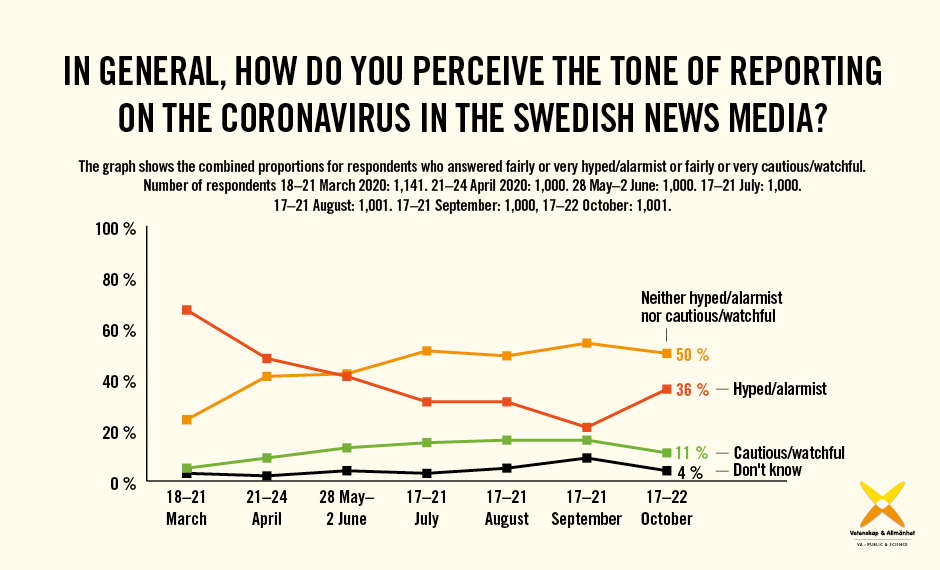
Confidence in healthcare professionals and researchers remains stable
The Swedish public’s confidence in various professional groups that comment on the coronavirus in the Swedish media remained largely unchanged between September and October. Nine out of ten (90 percent) Swedes had fairly or very high confidence in doctors and other healthcare professionals, while the corresponding proportions were 85 percent for researchers, 61 percent for government officials, 21 percent for politicians and 20 percent for journalists.
Women had greater confidence than men in researchers, politicians and government officials. The greatest difference was in how government officials are perceived, with 68 percent of women and 55 percent of men having fairly or very high confidence in them in October.
Swedes’ perception of how in agreement various professional groups are in their views on how Sweden is handling the pandemic follows a similar pattern to when this was measured in September. Eight out of ten (83 percent) viewed doctors and healthcare professionals as fairly or very in agreement. This was followed by government officials (74 percent), researchers (65 percent), politicians (45 percent) and journalists (42 percent).
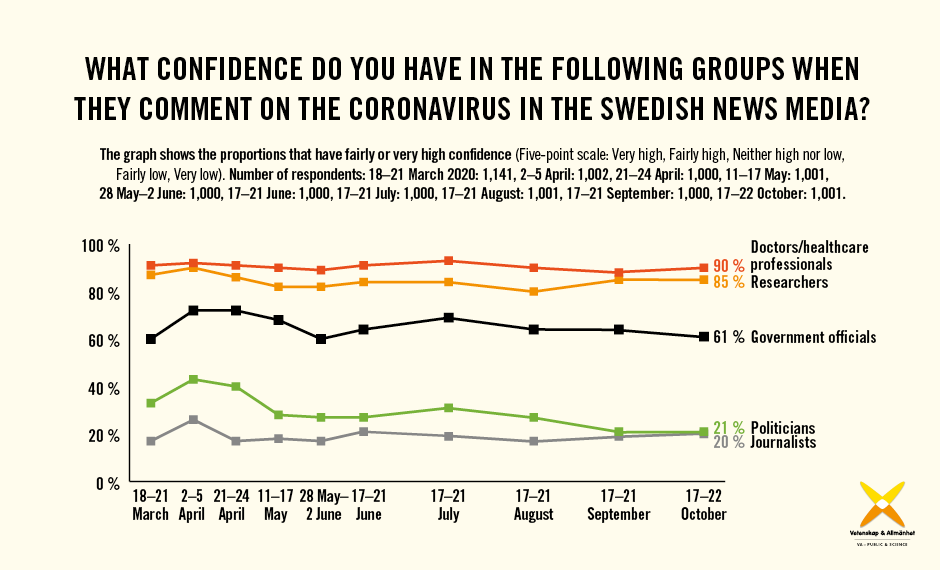
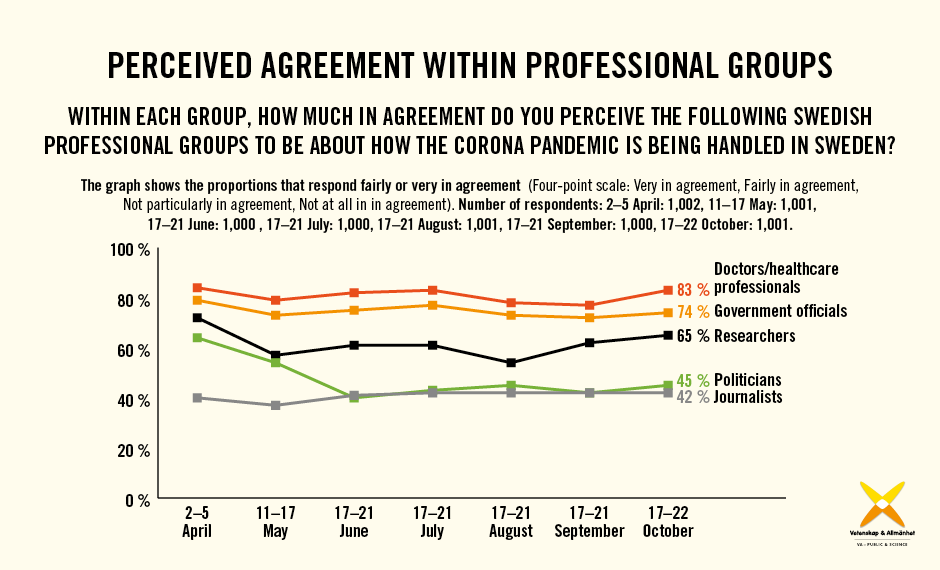
About the survey
The survey was conducted by Kantar Sifo and consisted of 1,001 interviews with a web panel based on random sampling. The interviews were conducted 17–21 October. The results are weighted based on gender, age and region of residence.
In order to monitor the Swedish public’s news consumption, confidence in key professional groups and attitudes towards media reporting over time, we are conducting a number of studies during the course of the pandemic. We also plan to undertake a content analysis of reporting on the coronavirus in the Swedish media in order to map any changes in reporting during different phases, and how this relates to public attitudes during the same time period.
The study is being conducted with the support of the Anne-Marie and Gustaf Anders Foundation for Media Research, Karolinska Institute, LIF – the Swedish Association of the Pharmaceutical Industry, Södertörn University, the Wenner-Gren Foundations and the Swedish Research Council.
Read more about VA’s study and the results of the first, second, third, fourth, fifth, sixth, seventh, eighth and ninth waves of the study.
